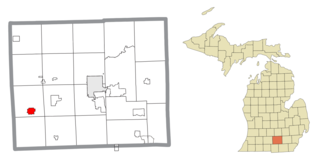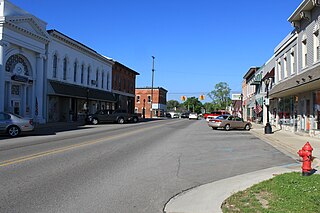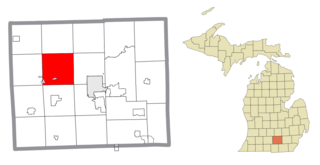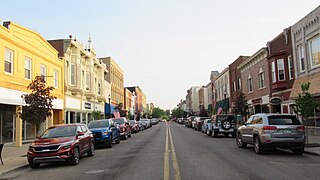
Concord is a village in Jackson County in the U.S. state of Michigan. The population was 1,050 at the 2010 census. The village is within Concord Township.

Denison is a city in Jackson County, Kansas, United States. As of the 2020 census, the population of the city was 146.

Elberta is a village in Benzie County in the U.S. state of Michigan. The population was 329 at the 2020 census. Located in Gilmore Township, Elberta overlooks Lake Michigan and lies across Betsie Lake from Frankfort. Elberta is part of Northern Michigan.

Eagle is a village in southwest Clinton County in the U.S. state of Michigan. The population was 122 at the 2020 census. The village is within Eagle Township in the southwest corner of the county. It is near Interstate 96 about 15 miles (24 km) northwest of Lansing.

Gladwin is a city in Gladwin County in the U.S. state of Michigan. The population was 3,069 at the 2020 census. Gladwin is the county seat of Gladwin County. The city is at the southwest corner of Gladwin Township, but the two are administered autonomously.

Brooklyn is a village in Jackson County in the U.S. state of Michigan. The population was 1,313 at the 2020 census. It is located in the Irish Hills region of southern Michigan, just north of U.S. Route 12 along M-50. The village is located within Columbia Township.

Grass Lake is a village in Jackson County in the U.S. state of Michigan. The population was 1,105 at the 2020 census. The village is located just south of Interstate 94 in Grass Lake Township.

Grass Lake Charter Township is a charter township of Jackson County in the U.S. state of Michigan. The population was 6,069 at the 2020 census, up from 5,684 at the 2010 census.

Parma Township is a civil township of Jackson County in the U.S. state of Michigan. The population was 2,668 at the 2020 census.

Sandstone Charter Township is a charter township of Jackson County in the U.S. state of Michigan. As of the 2020 census, the population was 3,927.

Spring Arbor Township is a civil township of Jackson County in the U.S. state of Michigan. The population was 8,530 at the 2020 census, up from 8,267 at the 2010 census.

Adrian is a city in the U.S. state of Michigan and the county seat of Lenawee County. The population was 20,645 at the 2020 census. Adrian lies in Michigan's 5th congressional district.

Blissfield is a village in Lenawee County in the U.S. state of Michigan. The population was 3,340 at the 2010 census. The village is mostly located within Blissfield Township with only very small portions extending west into Palmyra Township and south into Riga Township. The Blissfield post office first opened March 28, 1828. Hervey Bliss, who was the first white settler in 1824 and for whom the town is named, was the first postmaster.

Fowlerville is a village in Livingston County in the U.S. state of Michigan. It is located in the northeast portion of Handy Township, but is politically independent from the township. The population was 2,951 at the time of the 2020 census.

Byron is a village in Shiawassee County in the U.S. state of Michigan. The population was 581 at the 2010 census. The village is located within Burns Township.

Gordonville is a village in Cape Giradeau County, Missouri, United States. The population was 625 at the 2020 census. It is part of the Cape Girardeau–Jackson, MO-IL Metropolitan Statistical Area.

Oak Ridge is a village in the southern part of Apple Creek Township in Cape Girardeau County, Missouri, United States. The population was 237 at the 2020 census. It is part of the Cape Girardeau–Jackson, MO-IL Metropolitan Statistical Area.

Decatur is a village in Van Buren County, Michigan, United States. The population was 1,819 at the 2010 census. The village is located within Decatur Township.

Stoneboro is a borough in eastern Mercer County, Pennsylvania, United States. The population was 946 at the 2020 census. It is part of the Hermitage micropolitan area.

Spring Arbor is an unincorporated community and census-designated place (CDP) in Jackson County in the U.S. state of Michigan. The population of the CDP was 2,881 at the 2010 census, up from 2,188 at the 2000 census. The CDP is located within Spring Arbor Township.






















